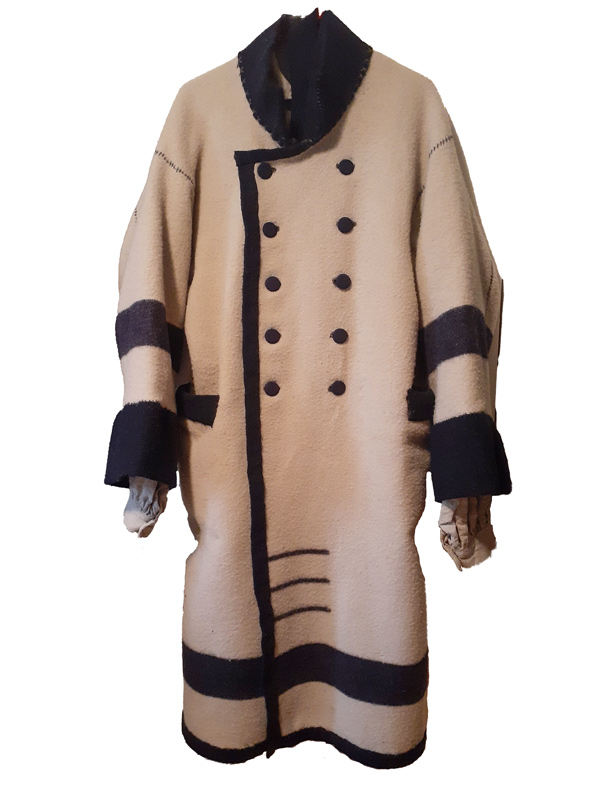On behalf of the expedition, Israel Whelan, U.S. Army Purveyor of Public Supplies in Philadelphia, buys wool blankets, pants, watch coats, and stockings. Receipts for today also include a tent, flannel shirts, Hyson tea, Castile soap, and 176 pounds of black powder.
Watch coats were issued by the U.S. military at the time of the Lewis and Clark Expedition. Like a capote, they are made from trade blankets, but they have a collar instead of a hood. The above coat was created by Kris Townsend and Lyle Gleason based on the research of Gene Hickman.
Cloth Goods
Purveyor’s Office 28 May 1803
Sir:
By request of Captain Lewis the articles mention’d at foot are sent to be pack’d at the Arsenal in a suitable Cask . . . . Fifteen coatees will be sent out also when made up.
B. M. [Benjamin Mifflin]
1 Common Tent
15 Blankets
15 Watch Coats
15 Pr. Wool overalls (blue)
30 Pairs stockgs.20 frocks
30 prs linen sheets
45 Flannel shirts
48 Calico ShirtsP. Kelly[1]“Supplies from Private Vendors,” in Letters of the Lewis and Clark Expedition with Related Documents: 1783-1854, 2nd ed., ed. Donald Jackson (Urbana: University of Illinois Press, 1978), … Continue reading
Benjamin Mifflin was assistant to Israel Whelan and may have owned a mercantile in Philadelphia.
Tea
Israel Whelen bot. of Pricilla Logan 1803 May 28 2 lbs. Hyson Tea @ 12/6 £1.5 Cannister £1.8.6 [$3.80] [2]Ibid., 82.
Castile Soap
Philada. 28 May 1803 Israel Whelen Esquire Bot. of Beck & Harvey 123 lbs. English Cannister Powder at 90 cts pr. lb. 110.70 53 lbs. dbl. Seal Ditto in papers at 85 cts. 45.05 155.75 17 6/12 lbs. Castile Soap 1.68 $157.43 [Endorsement:] Of this Bill there are chd. to Ord. Dept. [Ordinance Department] $155.75.[5]Jackson, 87.
Originally from the Castile region of Spain, castile soap is made from olive oil and removes glycerin and lye by adding a salty brine during the boiling. This results in a soap that gets harder with time.[6]“Castile Soap,” Wikipedia, https://en.wikipedia.org/wiki/Castile_soap accessed 5 June 2022.
Experience the Lewis and Clark Trail
The Lewis and Clark Trail Experience—our sister site at lewisandclark.travel—connects the world to people and places on the Lewis and Clark Trail.
Plan a trip related to May 28, 1803:

Notes
| ↑1 | “Supplies from Private Vendors,” in Letters of the Lewis and Clark Expedition with Related Documents: 1783-1854, 2nd ed., ed. Donald Jackson (Urbana: University of Illinois Press, 1978), 77. |
|---|---|
| ↑2 | Ibid., 82. |
| ↑3 | “List of Groceries for Monticello, 6 February 1803,” Founders Online, National Archives, founders.archives.gov/documents/Jefferson/01-39-02-0395 accessed 15 May 2022. [Original source: The Papers of Thomas Jefferson, vol. 39, 13 November 1802–3 March 1803, ed. Barbara B. Oberg. Princeton: Princeton University Press, 2012, p. 463.] |
| ↑4 | “Hyson,” Wikipedia, en.wikipedia.org/wiki/Hyson; “The Shop: Monticello” archived at web.archive.org/web/20170813200846/http://www.monticelloshop.org/206642.html both accessed 5 June 2022. |
| ↑5 | Jackson, 87. |
| ↑6 | “Castile Soap,” Wikipedia, https://en.wikipedia.org/wiki/Castile_soap accessed 5 June 2022. |

